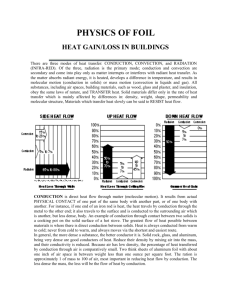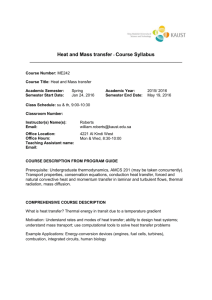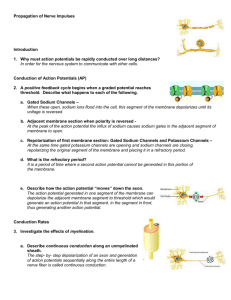CONDUCTION INTRODUCTION OBJECTIVES
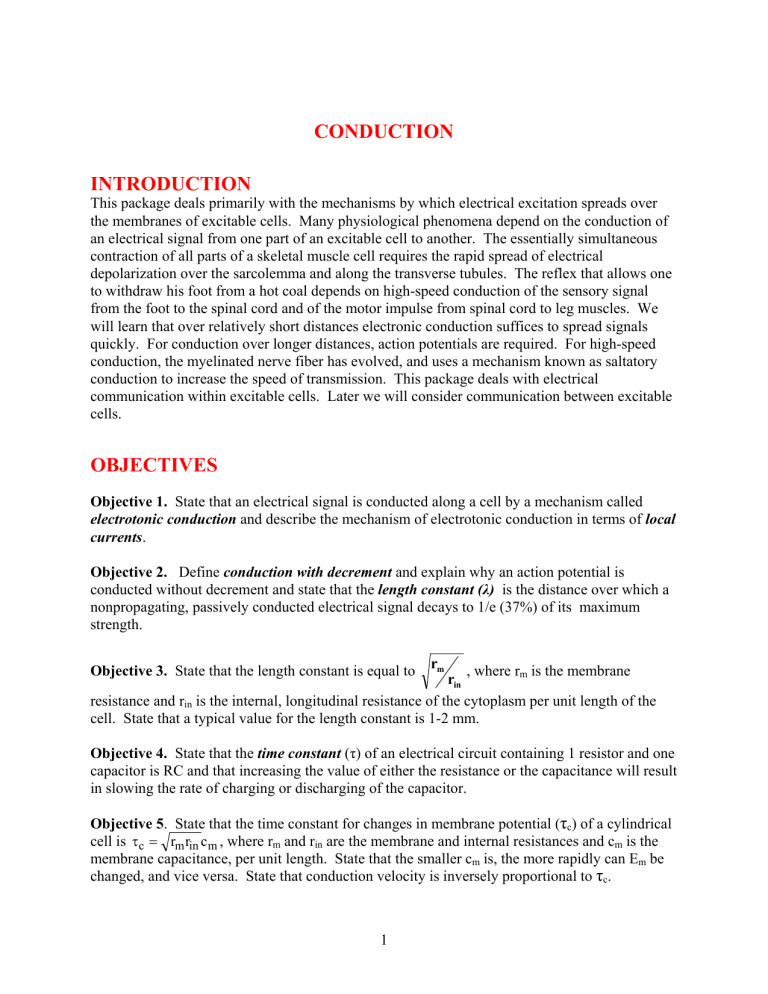
CONDUCTION
INTRODUCTION
This package deals primarily with the mechanisms by which electrical excitation spreads over the membranes of excitable cells. Many physiological phenomena depend on the conduction of an electrical signal from one part of an excitable cell to another. The essentially simultaneous contraction of all parts of a skeletal muscle cell requires the rapid spread of electrical depolarization over the sarcolemma and along the transverse tubules. The reflex that allows one to withdraw his foot from a hot coal depends on high-speed conduction of the sensory signal from the foot to the spinal cord and of the motor impulse from spinal cord to leg muscles. We will learn that over relatively short distances electronic conduction suffices to spread signals quickly. For conduction over longer distances, action potentials are required. For high-speed conduction, the myelinated nerve fiber has evolved, and uses a mechanism known as saltatory conduction to increase the speed of transmission. This package deals with electrical communication within excitable cells. Later we will consider communication between excitable cells.
OBJECTIVES
Objective 1.
State that an electrical signal is conducted along a cell by a mechanism called electrotonic conduction and describe the mechanism of electrotonic conduction in terms of local currents .
Objective 2. Define conduction with decrement and explain why an action potential is conducted without decrement and state that the length constant ( λ ) is the distance over which a nonpropagating, passively conducted electrical signal decays to 1/e (37%) of its maximum strength.
Objective 3. State that the length constant is equal to r m r in
, where r m
is the membrane resistance and r in
is the internal, longitudinal resistance of the cytoplasm per unit length of the cell. State that a typical value for the length constant is 1-2 mm.
Objective 4. State that the time constant ( τ ) of an electrical circuit containing 1 resistor and one capacitor is RC and that increasing the value of either the resistance or the capacitance will result in slowing the rate of charging or discharging of the capacitor.
Objective 5 . State that the time constant for changes in membrane potential ( cell is τ c
= r m r in c m
, where r m
and r in
τ c
) of a cylindrical
are the membrane and internal resistances and c m
is the membrane capacitance, per unit length. State that the smaller c m
is, the more rapidly can E m
be changed, and vice versa. State that conduction velocity is inversely proportional to τ c
.
1
Objective 6. Explain in terms of τ c why a large diameter cell conducts an electrical signal faster that a smaller diameter cell.
Objective 7. Explain the effect of myelination on r myelination on τ c
(the time constant for conduction) m
, r in
, c m
of an axon. Explain the effect of and on conduction velocity.
Objective 8 . Describe saltatory conduction in a myelinated axon. Explain why the action potential is conducted rapidly with little decrement between nodes of Ranvier. Explain why the action potential is regenerated only at the nodes of Ranvier.
PRACTICE CYCLE #1
Objective 1.
State that an electrical signal is conducted along a cell by a mechanism called electrotonic conduction and describe the mechanism of electrotonic conduction in terms of local currents
INPUT 1
.
Figure 1. Electrotonic conduction The mechanism whereby a change in the membrane potential at one location is spread in all directions..
The axon shown in Fig . 1 has a central depolarized region. Since axoplasm and extracellular fluid (ECF) are good conductors, currents will flow. By convention currents always flow from + toward minus and current is defined as the flow of positive charges. These are known as local currents (a.k.a. local circuit currents) .
These currents cause the depolarization to spread in both directions down the axon. This mechanism is called electrotonic conduction.
Each area that becomes depolarized then generates currents that depolarize the next area. Depolarizations, hyperpolarizations, and action potentials spread by this same mechanism.
2
PRACTICE 1
Describe the response to a localized subthreshold depolarization of the membrane.
FEEDBACK 1
(You might benefit from answering this question by explaining eletrotonic conduction to a colleague until you both are satisfied).
Did you say something like the following? When an area of the membrane is depolarized local currents flow, which depolarize the adjacent regions of the membrane. These regions then depolarize the regions adjacent to them, etc. In this way the depolarization is conducted in both directions from the original point of depolarization.
PRACTICE CYCLE #2
Objective 2. Define conduction with decrement and explain why an action potential is conducted without decrement and state that the length constant ( λ ) is the distance over which a nonpropagating, passively conducted electrical signal decays to 1/e (37%) of its maximum strength.
INPUT 2
Due to current losses a subthreshold depolarization or hyperpolarization loses strength as it is conducted electrotonically (passively) along the cell membrane. An action potential does not lose strength because it is regenerated at multiple places along the cell membrane as it is conducted. For that reason we may say that an action potential is
propagated
, rather than merely passively conducted along a cell. Figure 2 shows the loss of strength of a passively conducted signal as it moves along a cell.
5
4
3
2
V = V max
/e
1
λ = 1.5 mm
0
0.0
0.5
1.0
1.5
2.0
2.5
mm from stimulating electrode
3.0
Figure 2. A subthreshold stimulus is administered to a cell via a stimulating electrode. The response of the membrane potential is largest right at the stimulating electrode. As the stimulus is conducted along the cell it decays in strength.
3
Because the electrical signal (the change in membrane potential) decreases in size as it is conducted along the the cell, this is called
conduction with decrement.
The distance over which the signal decreases to 1/e (37%) of its maximum strength is call the
length constant ( λ )
of the cell. (e is the base of natural logarithms and is equal to 2.7182…) A typical value of the length constant is 1 to 2 mm. Many skeletal muscle cells are on the order of a cm long and certain spinal motor and sensory neurons are about 1 m long. Electrotonic conduction (conduction with decrement) will not suffice for such long cells. On the other hand, electrotonic conduction may serve the communication needs of much smaller cells quite well.
PRACTICE 2
Describe conduction with decrement, define the length constant and give its approximate value.
FEDEDBACK 2
Did you say something like the following? Conduction with decrement refers to the passive conduction of a nonpropagating signal. The signal decays in strength as it is conducted. The length over which the signal decays to 1/e (37%) of its maximum strength is called the length constant. The length constant of a typical cell is 1 to 2 mm.
PRACTICE CYCLE #3
Objective 3. State that the length constant is equal to r m r in
, where r m
is the membrane resistance and r in cell.
is the internal, longitudinal resistance of the cytoplasm per unit length of the
INPUT 3
A cylindrical cell can be regarded as an electrical cable. The cytosol, a good conductor, can be thought of as the wire in a cable. The membrane, a poor conductor, can be thought of at the insulation on the cable.
Figure 3. A cylindrical cell considered as a cable. r m
is the resistance to current flow across the membrane and r in
is the resistance to current flow along the long axis of the cell.
Current that flows along the long axis of the cell carries the electrical signal. Current that flows across the membrane is “lost”. If r m
were infinite, the cell would be a perfect cable and the signal would be conducted with no loss of strength. The higher the value of r m
relative to r in
, the
4
better the cable and the smaller the decrement (the greater the length constant, λ ) as the signal is conducted. It turns out that λ = r m r in
PRACTICE 3
If the longitudinal resistance (r membrane resistance (r m in
) of a cylindrical cell decreased by a factor of 4 and the
) decreased by a factor of 2, how would the length constant change?
FEEDBACK 3
Did you say that the length constant would increase by a factor of √ 2? Since λ = r m r in
, with a decrease in the numerator by 2-fold and a decrease the denominator by 4-fold, the fraction would increase by a factor of 2 and the length constant would thus increase by √ 2. This is what happens when a cylindrical cell doubles in radius. The internal longitudinal resistance decreases with the increased cross-sectional area proportionally to the square of the radius. Thus r in decreases by a factor of 4. The membrane resistance decreases with the increased membrane area and thus decreases proportionally to the radius (the membrane area is 2 π rl, where l is the length of the cell. Thus the membrane resistance thus decreases by a factor of 2. In the central nervous system fatter dendrites have a larger length constant than skinny dendrites. This has functional consequences.
PRACTICE CYCLE #4
Objective 4. State that the time constant ( τ ) of an electrical circuit containing 1 resistor and one capacitor is RC and that increasing the value of either the resistance or the capacitance will result in slowing the rate of charging or discharging of the capacitor.
INPUT 4
A capacitor has an electrically insulating layer in the middle with conductive layers on either side of it.
Biological membranes are constructed like this. The hydrophobic lipid bilayer is an electrical insulator, while the cytosol and extracellular fluid are good conductors.
When there is a membrane potential, charge is stored on the membrane capacitor. The amount of charge stored is equal to C ∆ V = C m
E m
, where C m
is the membrane capacitance and E m
is the membrane potential. To change the membrane potential requires time. To learn how much time is required, consider a simple circuit with one resistor (R) and one capacitor (C)
5
When switch A is closed the capacitor charges to 10 volts ( see figure below )
When switch A is opened the capacitor retains its charge
When switch B is closed current flows and the capacitor is discharged
The figure below shows what happens when the capacitor in the circuit above is charged and then discharged. If R is larger, current is smaller and discharge rate is slower. If C is larger, more charge is stored, so the discharge takes longer
The time course of the charging and discharge of the capacitor follows an exponential time course. The time for the charging or discharging is characterized by the time constant ( τ ) of the circuit. τ is equal to R times C. The larger the value of the time constant ( τ ), the slower the capacitor can charge up or discharge. This is because with a larger value of C, more charge is stored on the capacitor and the larger the value of R the smaller the current flow and the longer it takes to discharge the capacitor.
PRACTICE 4
With reference to the figure immediately above, how would the figure be different if the value of
C were doubled? If the value of R were doubled?
FEEDBACK 4
Did you say that if either R of C were doubled the rates of both charging the capacitor and discharging the capacitor would be similarly reduced by a factor of 2?
PRACTICE CYCLE #5
Objective 5 . State that the time constant for changes in membrane potential ( τ m
) of a cylindrical cell is
τ
c
=
r m r in
C m where r m
and r in
are the membrane and internal resistances and c m
is the membrane capacitance, per unit length. State that the smaller c m
is, the more rapidly can E m
be changed, and vice versa.
State that conduction velocity is inversely proportional to τ m
.
6
INPUT 5
In order to depolarize a cell, its membrane capacitor must be discharged. The amount of charge
( ∆ Q) that must flow to discharge the membrane capacitor by a voltage ∆ V is ∆ Q = C m larger the capacitance, C m
, the greater ∆ Q must be in order to change ∆
∆ V .
The
V by a given amount.
When a nerve fiber is depolarized, current flows electrotonically as shown in the figure in
Practice Cycle#1. Current flows in the cytosol and extracellular fluid and across the membrane discharge the membrane capacitor. The equivalent circuit for a cylindrical cell, such as a muscle fiber or nerve axon, is shown below where c m membrane resistance.
is the membrane capacitance and r m
is the
The larger the value of c m
, the more charge is stored on the membrane capacitor. The higher the membrane resistance (r m by a given depolarization. Thus c a cell to threshold and r m flow. Increasing r m
, r in
) and the internal resistance (r in
and r in
, or c m m time constant of the circuit shown above is the
), the smaller will be the currents induced
determines the amount of charge flow required to depolarize
are the primary determinants of how rapidly that charge can
makes it more difficult to depolarize the membrane quickly. The
time constant for conduction, τ
c is
τ
c
=
r m r in
C m
The larger is the time constant, the slower is the rate at which the membrane capacitor can be discharged and thus the slower the velocity of conduction of a membrane potential change in response to a given stimulus. Conduction velocity is inversely proportional to the time constant for conduction.
PRACTICE 5
What is the time constant for conduction? If the time constant for conduction is small, what does that imply about the velocity of conduction? If r m
increases by a factor of 4, what will happen to the time constant for conduction and the conduction velocity?
7
FEEDBACK 5
Did you say that the membrane time constant for conduction is equal to
τ c
= r m r in
C m and that the smaller the time constant the higher the conduction velocity? Good. A smaller time constant means that less time is required to discharge or charge the plasma membrane and thus the more rapidly a change in membrane potential can be conducted. An increase in r m
by a factor of 4 will increase τ c
by a factor of 2 and decrease conduction velocity by a factor of 2.
PRACTICE CYCLE #6
Objective 6. Explain, in terms of τ faster than a smaller diameter cell. c
, why a large diameter cell conducts an electrical signal
INPUT 6
Considering the time constant for conduction ( τ c
) will allow us to predict how τ c and thus the velocity of conduction should vary with the radius (a) of the conducting axon. Membrane capacitance (c m
) should increase linearly with increasing membrane area, while r m
will decrease in proportion to an increase in membrane area. Membrane surface area (surface area = 2 π a x length) increases directly with increasing radius. Thus c m proportion to the radius of the axon. Internal resistance (r inversely on the cross-sectional area of the cell (A x
= π a 2
will increase and r in
), on the other hand, depends
), so that r m
will decrease in in
will vary inversely with a 2 .
To summarize, with increasing radius (a)
r m
r in
c m
decreases proportional to the increase in radius
decreases in proportion to the square of the increased radius
increases in proportion to the increase in radius
τ c
= r m r in c m
= ( 1 / a )( 1 / a
2
) a = 1 / a
So the time constant for conduction decreases as the radius increases, which is why a larger diameter axon has a faster conduction velocity than a smaller diameter axon. The increase in conduction velocity is thus proportional to the square of the radius of the axon.
8
PRACTICE 6
If we compare two axons that are similar in every respect except that axon B has 25 times greater diameter than axon A. What will be the relative conduction velocities in the two axons?
FEEDBACK 6
Did you say that axon B will have conduction velocity 5 times that of A? Good. Since the time constant for is inversely proportional to the square root the radius, the time constant for conduction will be 5 times less in axon B than in axon A. Thus the conduction velocity of B will be 5 times greater than that of axon A.
PRACTICE CYCLE #7
Objective 7. Explain the effect of myelination on r m
, r in
, c m
of an axon. Explain the effect of myelination on τ c and on conduction velocity.
INPUT 7
A myelinated nerve fiber has a much high conduction velocity than an unmyelinated fiber of the same diameter. Let's see why this is the case. The wrappings of Schwann cell membranes that constitute the myelin sheath greatly increase the electrical insulation (higher r m
) of the fiber and make it a more perfect cable. For this reason there is an increase in the length constant due to myelination. The myelin sheath also causes a great increase in the rate of electrotonic conduction.
This occurs because τ c
= r m r in c m
decreases. r in
is not affected but r m
is increased and c m
is decreased. The individual myelin membranes each acts as capacitor and they are arranged in series. Capacitors in series add like resistors in parallel (1/Ct = 1/C1 + 1/C2.....1/Cn). Thus 50
Schwann cell wrappings (100 plasma membranes) will cause the axon to have a total membrane capacitance that is 100 times less than that of a single membrane. r m
100 times greater. Since r in
, on the other hand will be
does not change the time constant changes as shown:
τ c
= r m r in c m
= ( 100 )( 1 )( 1 / 100 ) = 1 / 100 = 1 / 10
So with 100 myelin membranes, the value of τ c
will be one-tenth that for an unmyelinaed axon of the same diameter. Since τ c
is decreased by a factor of 10, conduction velocity will increase by a factor of 10. This predicts that a myelinated nerve fiber will have a conduction velocity much greater than an unmyelinated fiber of the same dimensions and properties.
9
PRACTICE 7
Consider two axons of the same diameter, one myelinated, the other unmyelinated. Compare
1) r i
, 2) r m,
3) c m
FEEDBACK 7
, 4) τ c
, and 5) velocity of electrotonic conduction.
Did you say:
1) r i
is the same.
2) r m
is much larger in the myelinated axon.
3) c m
4) τ c
is much smaller in the myelinated axon.
is smaller for the myelinated axon.
5) Since the myelinated axon has a smaller time constant for conduction, it has a higher conduction velocity.
PRACTICE CYCLE #8
Objective 8 . Describe saltatory conduction in a myelinated axon. Explain how the action potential is conducted between nodes of Ranvier. Explain how the action potential is regenerated at each node.
INPUT 8
Conduction of an action potential in myelinated fibers occurs by a process known as saltatory conduction. By this we mean that the action potential is conducted with great speed between nodes (due to greatly decreased time constant for conduction) and pauses to regenerate itself only at the nodes of Ranvier. The nodes of Ranvier occur about every mm which is a good deal less than the length constant of the cell, which is greatly increased due to the myelination. This assures that the action potential arrives at the next node with sufficient punch to generate an action potential there. Furthermore, the internodal areas fail to fire action potentials. If there are approximately 100 plasma membranes in series in the internodal region, the potential change during the conducted action potential is spread among the 100 membranes. Thus the depolarization of the plasma membranes of the axon is only about 1 mV, not nearly enough to reach threshold. In addition, the Na + and K + channels that are central to the action potential are highly concentrated in the nodal plasma membrane. Thus the action potentials are regenerated only at the nodes of Ranvier. Since the nodes are a small fraction of the plasma membrane surface area, myelination results in a great enhancement of the energetic efficiency of neuronal signaling.
PRACTICE 8
Describe saltatory conduction. Describe how the action potential is propagated in the internodal areas. Describe how the action potential is propagated at the Nodes.
FEEDBACK 8
Did you say something like this? In saltatory conduction the action potential is conducted very rapidly with little decrement between nodes by electrotonic conduction. This is because the myelination greatly decreases the time constant and increases the length constant of the internodal region. The myelin sheath also prevents the internodal areas from firing action potentials. At each node the action potential "pauses" to regenerate itself.
10
POST TEST
1. Describe how electrotonic conduction occurs.
2. What is meant by "conduction with decrement"? Define the length constant? What is a typical value of the length constant for mammalian cells? Why is an action potential propagated without decrement?
3. How does the length constant ( λ ) depend on the membrane resistance and the internal resistance?
4. What is meant by the time constant ( τ ) of an electrical circuit with only one capacitor and one resistor. How does it depend on the values of R (the resistance of the resistor) and C (the capacitance of the capacitor?
5. Define (symbols and words) the time constant for conduction ( τ c cell. How does the conduction velocity depend on capacitance be expected to influence τ c
τ
) of an electrical signal in a c
? How would a decrease in membrane and conduction velocity?
6. Explain in terms of r smaller axon. in
, r m
, and c m
why a larger axon has a higher conduction velocity than a
7. What effect does myelination have on r m
, r in
, c m
?
How do these changes affect the time constant for conduction and conduction velocity?
8. Describe saltatory conduction. What happens in the internodal regions? What happens at the
Nodes of Ranvier? Why does the internodal membrane fail to fire an action potential?
11
ANSWERS TO POST-TEST
1. Electrotonic conduction occurs by passive flow of electrical currents between adjacent membrane areas at different electrical potentials. In this way a local depolarization or hyperpolarization is spread in both directions along the length of the cell.
2. An electrotonically conducted electrical signal decreases in strength as it is conducted along the cell membrane; this is called "conduction with decrement". The length constant is the distance over which an electrotonically conducted signal decays to 37% (1/e) of its original value. A typical length constant for a mammalian neuron or muscle fiber is 1-2 mm. An action potential is regenerated as it is conducted and thus is conducted with no decrement. For this reason we say that the action potential is propagated.
3. The length constant ( λ ) increases with an increasing ratio of r m
/r in
λ = r m r in
4. The time constant ( τ ) of a circuit with only one resistor and one capacitor is equal to RC, where R is the resistance of the resistor and C is the capacitance of the capacitor. It is the time required for the charging up or the discharging of the capacitor to reach [1 - (1/e)] or 63% of completion. Increasing either R or C slows down the rate of charging and discharging.
5. The time constant for conduction τ c
of an electrical signal is
τ c
= r m r in c m where r m
, r in
, and c m
are the membrane resistance, the internal resistance, and the membrane capacitance per length of a cylindrical cell. The larger the time constant the longer the time required to change the membrane potential and thus the slower the conduction velocity. A decrease in membrane capacitance would decrease the time constant for conduction and result in higher conduction velocity.
6. r in decreases with increasing cross-sectional area (proportional the square of the radius) of a cylindrical cell. r m
decreases proportionally to the surface area (proportional to the radius). But c m increases with membrane surface area (proportional to radius). So, if the radius of the cell is a
τ c
= r m r in
C m
= ( 1 / a )( 1 / a
2
) a = 1 / a
Thus the time constant for conduction decreases with the square root of the radius and conduction velocity increases with the square root of the radius. The larger the fiber, the larger its conduction velocity.
12
7. The effect of myelination is to increase r m has no effect on r in
and decrease c m
to the same extent. Myelination
. In a case where myelination increases r of 100, the effects on the time constant for conduction are m
and decreases c m
, both by a factor
τ c
= r m r in c m
= ( 100 )( 1 )( 1 / 100 ) = 1 / 100 = 1 / 10
So that the time constant for conduction decreases and hence conduction velocity increases with myelination.
8. In saltatory conduction the impulse is very rapidly conducted electrotonically between adjacent nodes of Ranvier with little decrement. This is because the myelination greatly increases the velocity of electrotonic conduction and the length constant in the internodal areas.
The internodal plasma membrane cannot fire an action potential, so the action potential "pauses" to regenerate itself at each node of Ranvier. Thus the action potential is said to "jump" from node to node.
13

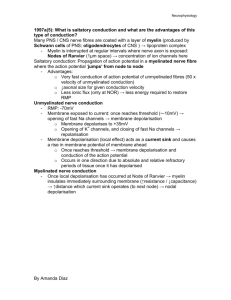

![Applied Heat Transfer [Opens in New Window]](http://s3.studylib.net/store/data/008526779_1-b12564ed87263f3384d65f395321d919-300x300.png)

